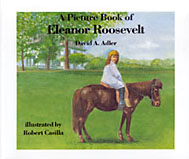Lesson Two: Eleanor Roosevelt, Helping People
Grade Level: This is a curriculum for first or second graders.
 |  |
Objectives:
- To introduce students to Eleanor Roosevelt the person.
- To introduce students to how she cared about people.
- To introduce students to the concept of leadership.
- To encourage teachers to read genre of biographies as part of their oralreading library.
- To have teachers model for students the importance of reading biographies.
- To learn 6 historical facts about Eleanor Roosevelt which reinforce Eleanor Roosevelt’s importance as an American leader.
- To introduce the term “Humanitarian,” and develop a stronger sense of Eleanor Roosevelt’s humanitarian work.
- To encourage students to become leaders by helping others.
Methodology:
Read children’s biographies of Eleanor Roosevelt.
Use questions and answers and storytelling techniques to talk about her life and activities.
Show pictures of Eleanor Roosevelt engaged in various activities.
Post pictures of Eleanor Roosevelt in the classroom on a weekly basis to remind students of who she was and what she did.
Have children draw pictures of Eleanor and her activities that reflect her personality.
Critical Thinking Activities:
Pre-reading activity: Teacher asks class, "What is a leader? What do you think when someone says, 'That person is a leader'?"
Read either: A Picture Book of Eleanor Roosevelt by David A. Adler (ISBN: 0-8234-0856-6 Holiday House Books, 1991) $6.95 OR
Eleanor Everywhere: The Life of Eleanor Roosevelt by Monica Krulling (ISBN: 0-679-88996-5 Random House, 1999 $3.99)
(Both of these books are in wide circulation. If they are not available in your own library system, please use interlibrary loan.)
Suggestion: If you use the strategy of questions, while you read aloud, it would be helpful if throughout the book you ask questions that draw attention to Eleanor Roosevelt’s leadership.
After reading the books, the teacher could ask the following questions:
1. Who was a famous leader in Eleanor’s family?
[Her uncle was President Theodore Roosevelt] (Picture, p.7)
2. How did Eleanor help her husband, Franklin, become a leader when he struggled with polio?
[She went to meetings, traveled for him and helped him run for president.] (Picture, pp. 15-18)
3. When Franklin became president, what did Eleanor become?
[First Lady] (Picture, pp. 17-18)
4. As First Lady, how did Eleanor show she was a leader?
[She visited people, she spoke on the radio, she wrote a newspaper column, she traveled all over the country, she used her money to help poor people.]
5. How did Eleanor help Marian Anderson?
[She found another place for her sing when people would let her sing because she was African American.]
6. What did Eleanor do after World War II started?
[She traveled all over the world to visit American soldiers, brought home messages to their families, and helped people be less scared.]
7. When Franklin died, what did Eleanor do?
[She went to work at the United Nations, where she helped leaders of the world work for peace.].
You might say to your class, “we learned lots of way that Eleanor Roosevelt was a leader. Many times she showed she was a leader by helping people. ” And then ask them some of these questions:
1. What did Eleanor Roosevelt do to help people?
[She visited people, she spoke on the radio, she wrote a newspaper column, she traveled all over the country, she used her money to help poor people.]
2. What are ways today that people try to help other people?
[They cook meals for homeless people; They visit sick people; they help people learn to read; they teach English to people who come from other places; they stop fights; they share; and many more examples.]
There's a special term for people who help other people. It's our big word of the day: humanitarian. A humanitarian is a person who helps other people. What can you do to become a humanitarian?
[Share my toys; help my teacher clean up the classroom; help my parents put away the groceries after we go to the store; help a friend find a lost toy; collect canned food for the homeless; visit senior citizens; do not get into fights.]
Activities
We could write a poem about Eleanor Roosevelt as a leader.
We could write a song about Eleanor Roosevelt as a leader.
We could make a classroom mural about Eleanor Roosevelt as a leader.
We could write a letter telling our families what we learned about Eleanor Roosevelt as a leader.
We could write to the Eleanor Roosevelt Papers and tell the what we learned about Eleanor Roosevelt and ask any questions we still have.
Now that Eleanor has entered your classroom, here are other books to keep her there:
David A. Adler. A Picture Book of Eleanor Roosevelt. New York: Holiday House, 1991.
Ian Falconer. Olivia Saves the Circus. New York: Atheneum Books Books for Young Readers, 2001.
Rachel A. Koestler-Grack. The Story of Eleanor Roosevelt. Philadelphia: Chelsea Clubhouse, 2004.
Monica Kulling. Eleanor Everywhere: The Life of Eleanor Roosevelt. New York: Random House, 1999.
Mary Winget. Eleanor Roosevelt. New York: Backpack Books, 2003.
This educational program was prepared by the Eleanor Roosevelt Papers Project with funding from GE Fund through Save America's Treasures.

